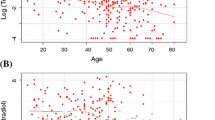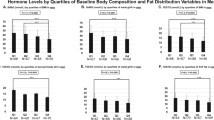Abstract
Purpose
To evaluate the association of body size—captured via whole-body dual-energy X-ray absorptiometry (DXA) and physical measurement—with serum sex steroid hormones and sex hormone binding globulin (SHBG), we utilized cross-sectional data and serum samples from the National Health and Nutrition Examination Survey (NHANES; 1999–2004).
Methods
Testosterone, androstanediol glucuronide (3-alpha-diol-G), estradiol, and SHBG were measured via immunoassay in serum samples from a total of 898 adult men (ages 20–90) participating in the morning examination. As part of the NHANES data collection, DXA scans and measurements of weight, height, and waist circumference were performed by trained staff. Linear regression was used to estimate associations between body size and hormone levels adjusted for potential confounders and NHANES sampling procedures.
Results
Total bone area (cm2) was inversely associated with total testosterone (ng/mL) [beta = −0.12; p value < 0.01], while bone mineral density (g/cm2) was inversely associated with SHBG (nmol/L) [beta = −17.16; p value = 0.01]. Increased percent body fat was associated with lower concentrations of total testosterone [beta = −0.16; p value < 0.01] and SHBG [beta = −1.11; p value < 0.01] and higher concentrations of free estradiol (fg/mL) [beta = 12.52; p value < 0.01].
Conclusions
Clinical measures of body fat (measured via DXA scan) and anthropometric measures of body fat (BMI and waist circumference) provided similar inferences regarding the association between increased body fat and hormone levels in men. Increased body fat was associated with lower circulating levels of testosterone (total and free) and SHBG and higher circulating levels of free estradiol in men, while decreased bone mineral density was associated with higher circulating levels of SHBG.
Similar content being viewed by others
References
Flegal KM, Graubard BI, Williamson DF, Gail MH (2005) Excess deaths associated with underweight, overweight, and obesity. JAMA 293(15):1861–1867
Flegal KM, Graubard BI (2009) Estimates of excess deaths associated with body mass index and other anthropometric variables. Am J Clin Nutr 89(4):1213–1219
Calle EE, Kaaks R (2004) Overweight, obesity and cancer: epidemiological evidence and proposed mechanisms. Nat Rev Cancer 4(8):579–591
Allen NE, Appleby PN, Davey GK, Key TJ (2002) Lifestyle and nutritional determinants of bioavailable androgens and related hormones in British men. Cancer Causes Control 13(4):353–363
Muller M, den Tonkelaar I, Thijssen JH, Grobbee DE, van der Schouw YT (2003) Endogenous sex hormones in men aged 40–80 years. Eur J Endocrinol 149(6):583–589
Svartberg J, Midtby M, Bonaa KH, Sundsfjord J, Joakimsen RM, Jorde R (2003) The associations of age, lifestyle factors and chronic disease with testosterone in men: the Tromso study. Eur J Endocrinol 149(2):145–152
Tamimi R, Mucci LA, Spanos E, Lagiou A, Benetou V, Trichopoulos D (2001) Testosterone and oestradiol in relation to tobacco smoking, body mass index, energy consumption and nutrient intake among adult men. Eur J Cancer Prev 10(3):275–280
Rohrmann S, Shiels MS, Lopez DS et al (2011) Body fatness and sex steroid hormone concentrations in US men: results from NHANES III. Cancer Causes Control 22(8):1141–1151
Falahati-Nini A, Riggs BL, Atkinson EJ, O’Fallon WM, Eastell R, Khosla S (2000) Relative contributions of testosterone and estrogen in regulating bone resorption and formation in normal elderly men. J Clin Invest 106(12):1553–1560
Barrett-Connor E, Mueller JE, von Muhlen DG, Laughlin GA, Schneider DL, Sartoris DJ (2000) Low levels of estradiol are associated with vertebral fractures in older men, but not women: the Rancho Bernardo study. J Clin Endocrinol Metab 85(1):219–223
Duffy DM, Legro RS, Chang L, Stanczyk FZ, Lobo RA (1995) Metabolism of dihydrotestosterone to 5 alpha-androstane-3 alpha, 17 beta-diol glucuronide is greater in the peripheral compartment than in the splanchnic compartment. Fertil Steril 64(4):736–739
Centers for Disease Control and Prevention (CDC) (2011) National Center for Health Statistics (NCHS). National Health and Nutrition Examination Survey Data. Hyattsville, MD: U.S. Department of Health and Human Services, Centers for Disease Control and Prevention
Nyante SJ, Graubard BI, Li Y, McQuillan GM, Platz EA, Rohrmann S, Bradwin G, McGlynn KA (2012) Trends in sex hormone concentrations in US males: 1988–1991 to 1999–2004. Int J Androl 35(3):456–466
Vermeulen A, Verdonck L, Kaufman JM (1999) A critical evaluation of simple methods for the estimation of free testosterone in serum. J Clin Endocrinol Metab 84(10):3666–3672
National Center for Health Statistics (2011) National Health and Nutrition Examination Survey body composition procedures manual. Hyattsville, MD: Division of Health and Nutrition Examiniation Surveys, National Center for Health Statistics, Centers for Disease Control and Prevention, U.S. Department of Health and Human Services
Schenker N, Borrud LG, Burt VL et al (2011) Multiple imputation of missing dual-energy X-ray absorptiometry data in the National Health and Nutrition Examination Survey. Stat Med 30(3):260–276
Slemenda CW, Longcope C, Zhou L, Hui SL, Peacock M, Johnston CC (1997) Sex steroids and bone mass in older men. Positive associations with serum estrogens and negative associations with androgens. J Clin Invest 100(7):1755–1759
van den Beld AW, de Jong FH, Grobbee DE, Pols HA, Lamberts SW (2000) Measures of bioavailable serum testosterone and estradiol and their relationships with muscle strength, bone density, and body composition in elderly men. J Clin Endocrinol Metab 85(9):3276–3282
Khosla S, Melton LJ III, Atkinson EJ, O’Fallon WM (2001) Relationship of serum sex steroid levels to longitudinal changes in bone density in young versus elderly men. J Clin Endocrinol Metab 86(8):3555–3561
Gennari L, Merlotti D, Martini G et al (2003) Longitudinal association between sex hormone levels, bone loss, and bone turnover in elderly men. J Clin Endocrinol Metab 88(11):5327–5333
Goderie-Plomp HW, van der Klift M, de Ronde W, Hofman A, de Jong FH, Pols HA (2004) Endogenous sex hormones, sex hormone-binding globulin, and the risk of incident vertebral fractures in elderly men and women: the Rotterdam study. J Clin Endocrinol Metab 89(7):3261–3269
Fink HA, Ewing SK, Ensrud KE et al (2006) Association of testosterone and estradiol deficiency with osteoporosis and rapid bone loss in older men. J Clin Endocrinol Metab 91(10):3908–3915
Greendale GA, Edelstein S, Barrett-Connor E (1997) Endogenous sex steroids and bone mineral density in older women and men: the Rancho Bernardo study. J Bone Miner Res 12(11):1833–1843
Amin S, Zhang Y, Sawin CT et al (2000) Association of hypogonadism and estradiol levels with bone mineral density in elderly men from the Framingham study. Ann Intern Med 133(12):951–963
Keles I, Aydin G, Basar MM et al (2006) Endogenous sex steroids and bone mineral density in healthy men. Joint Bone Spine 73(1):80–85
Mellstrom D, Johnell O, Ljunggren O et al (2006) Free testosterone is an independent predictor of BMD and prevalent fractures in elderly men: MrOS Sweden. J Bone Miner Res 21(4):529–535
Bjornerem A, Emaus N, Berntsen GK et al (2007) Circulating sex steroids, sex hormone-binding globulin, and longitudinal changes in forearm bone mineral density in postmenopausal women and men: the Tromso study. Calcif Tissue Int 81(2):65–72
Khosla S, Melton LJ III, Atkinson EJ, O’Fallon WM, Klee GG, Riggs BL (1998) Relationship of serum sex steroid levels and bone turnover markers with bone mineral density in men and women: a key role for bioavailable estrogen. J Clin Endocrinol Metab 83(7):2266–2274
Legrand E, Hedde C, Gallois Y et al (2001) Osteoporosis in men: a potential role for the sex hormone binding globulin. Bone 29(1):90–95
Paller CJ, Shiels MS, Rohrmann S et al (2009) Relationship of sex steroid hormones with bone mineral density (BMD) in a nationally representative sample of men. Clin Endocrinol (Oxf) 70(1):26–34
Murphy S, Khaw KT, Cassidy A, Compston JE (1993) Sex hormones and bone mineral density in elderly men. Bone Miner 20(2):133–140
Mellstrom D, Vandenput L, Mallmin H et al (2008) Older men with low serum estradiol and high serum SHBG have an increased risk of fractures. J Bone Miner Res 23(10):1552–1560
Schatzl G, Madersbacher S, Thurridl T et al (2001) High-grade prostate cancer is associated with low serum testosterone levels. Prostate 47(1):52–58
Hsing AW, Sakoda LC, Chua S Jr (2007) Obesity, metabolic syndrome, and prostate cancer. Am J Clin Nutr 86(3):s843–s857
Hsing AW (1996) Hormones and prostate cancer: where do we go from here? J Natl Cancer Inst 88(16):1093–1095
Slattery ML, Ballard-Barbash R, Edwards S, Caan BJ, Potter JD (2003) Body mass index and colon cancer: an evaluation of the modifying effects of estrogen (United States). Cancer Causes Control 14(1):75–84
Polderman KH, Gooren LJ, Asscheman H, Bakker A, Heine RJ (1994) Induction of insulin resistance by androgens and estrogens. J Clin Endocrinol Metab 79(1):265–271
Acknowledgments
This work was supported by the Intramural Research Program of the National Institutes of Health, Division of Cancer Epidemiology and Genetics, National Cancer Institute, Department of Health and Human Services.
Conflict of interest
The authors declare that they have no conflict of interest.
Author information
Authors and Affiliations
Corresponding author
Electronic supplementary material
Below is the link to the electronic supplementary material.
Rights and permissions
About this article
Cite this article
Trabert, B., Graubard, B.I., Nyante, S.J. et al. Relationship of sex steroid hormones with body size and with body composition measured by dual-energy X-ray absorptiometry in US men. Cancer Causes Control 23, 1881–1891 (2012). https://doi.org/10.1007/s10552-012-0024-9
Received:
Accepted:
Published:
Issue Date:
DOI: https://doi.org/10.1007/s10552-012-0024-9




